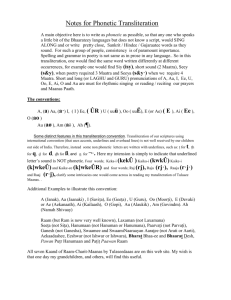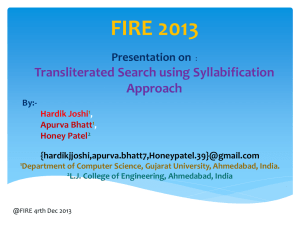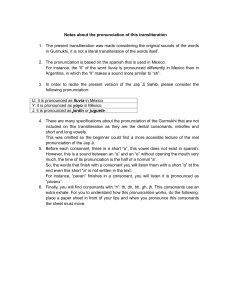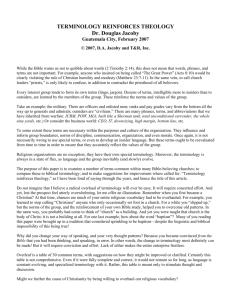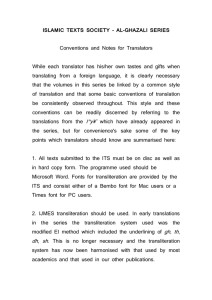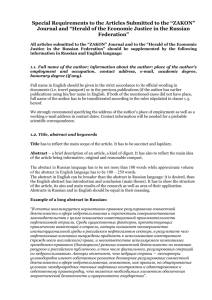Statistical Machine Translation Based Punjabi to English Transliteration System for Proper Nouns
advertisement
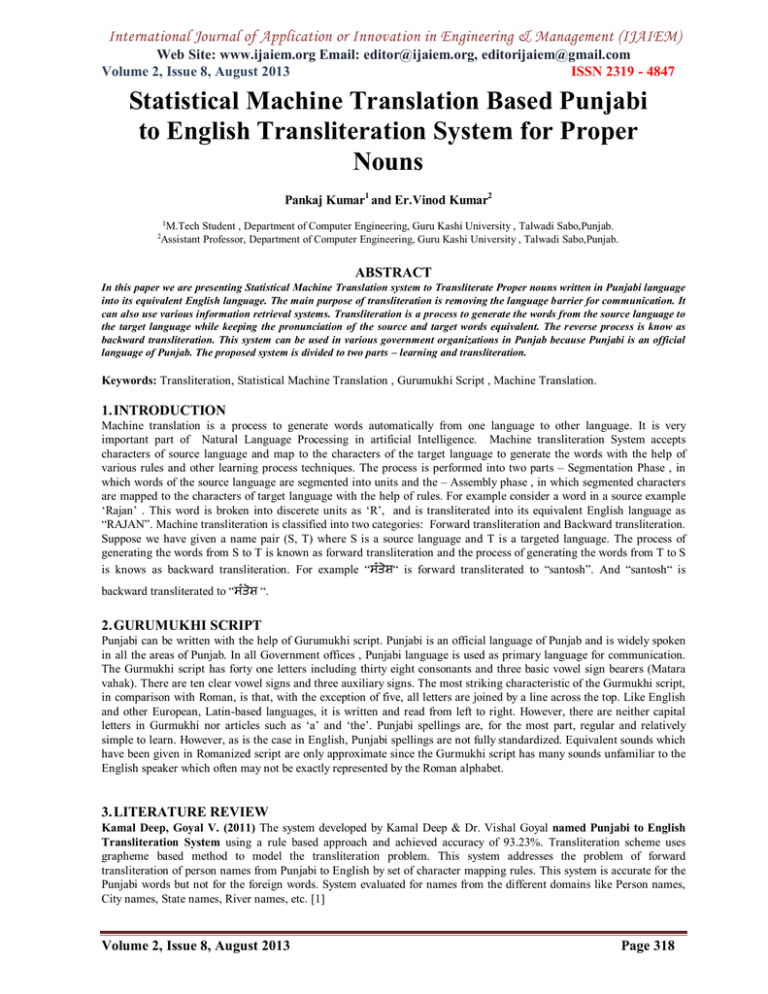
International Journal of Application or Innovation in Engineering & Management (IJAIEM) Web Site: www.ijaiem.org Email: editor@ijaiem.org, editorijaiem@gmail.com Volume 2, Issue 8, August 2013 ISSN 2319 - 4847 Statistical Machine Translation Based Punjabi to English Transliteration System for Proper Nouns Pankaj Kumar1 and Er.Vinod Kumar2 1 M.Tech Student , Department of Computer Engineering, Guru Kashi University , Talwadi Sabo,Punjab. Assistant Professor, Department of Computer Engineering, Guru Kashi University , Talwadi Sabo,Punjab. 2 ABSTRACT In this paper we are presenting Statistical Machine Translation system to Transliterate Proper nouns written in Punjabi language into its equivalent English language. The main purpose of transliteration is removing the language barrier for communication. It can also use various information retrieval systems. Transliteration is a process to generate the words from the source language to the target language while keeping the pronunciation of the source and target words equivalent. The reverse process is know as backward transliteration. This system can be used in various government organizations in Punjab because Punjabi is an official language of Punjab. The proposed system is divided to two parts – learning and transliteration. Keywords: Transliteration, Statistical Machine Translation , Gurumukhi Script , Machine Translation. 1. INTRODUCTION Machine translation is a process to generate words automatically from one language to other language. It is very important part of Natural Language Processing in artificial Intelligence. Machine transliteration System accepts characters of source language and map to the characters of the target language to generate the words with the help of various rules and other learning process techniques. The process is performed into two parts – Segmentation Phase , in which words of the source language are segmented into units and the – Assembly phase , in which segmented characters are mapped to the characters of target language with the help of rules. For example consider a word in a source example ‘Rajan’ . This word is broken into discerete units as ‘R’, and is transliterated into its equivalent English language as “RAJAN”. Machine transliteration is classified into two categories: Forward transliteration and Backward transliteration. Suppose we have given a name pair (S, T) where S is a source language and T is a targeted language. The process of generating the words from S to T is known as forward transliteration and the process of generating the words from T to S is knows as backward transliteration. For example “ਸੰ ਤੋਸ਼“ is forward transliterated to “santosh”. And “santosh“ is backward transliterated to “ਸੰ ਤੋਸ਼ “. 2. GURUMUKHI SCRIPT Punjabi can be written with the help of Gurumukhi script. Punjabi is an official language of Punjab and is widely spoken in all the areas of Punjab. In all Government offices , Punjabi language is used as primary language for communication. The Gurmukhi script has forty one letters including thirty eight consonants and three basic vowel sign bearers (Matara vahak). There are ten clear vowel signs and three auxiliary signs. The most striking characteristic of the Gurmukhi script, in comparison with Roman, is that, with the exception of five, all letters are joined by a line across the top. Like English and other European, Latin-based languages, it is written and read from left to right. However, there are neither capital letters in Gurmukhi nor articles such as ‘a’ and ‘the’. Punjabi spellings are, for the most part, regular and relatively simple to learn. However, as is the case in English, Punjabi spellings are not fully standardized. Equivalent sounds which have been given in Romanized script are only approximate since the Gurmukhi script has many sounds unfamiliar to the English speaker which often may not be exactly represented by the Roman alphabet. 3. LITERATURE REVIEW Kamal Deep, Goyal V. (2011) The system developed by Kamal Deep & Dr. Vishal Goyal named Punjabi to English Transliteration System using a rule based approach and achieved accuracy of 93.23%. Transliteration scheme uses grapheme based method to model the transliteration problem. This system addresses the problem of forward transliteration of person names from Punjabi to English by set of character mapping rules. This system is accurate for the Punjabi words but not for the foreign words. System evaluated for names from the different domains like Person names, City names, State names, River names, etc. [1] Volume 2, Issue 8, August 2013 Page 318 International Journal of Application or Innovation in Engineering & Management (IJAIEM) Web Site: www.ijaiem.org Email: editor@ijaiem.org, editorijaiem@gmail.com Volume 2, Issue 8, August 2013 ISSN 2319 - 4847 Vijaya, VP, Shivapratap and KP CEN(2009) has developed English to Tamil Transliteration system and named it WEKA.It is a Rule based system and used the j48 decision tree classifier of WEKA for classification purposes. The feature patterns has been extracted from In this system, the valid target language n-gram (yi) for a source language ngram (xi) in the given source language input word is decided by considering the source language context features such as source language n-gram (xi) , two left context n-grams (xi-2, xi-1) and two right context n- grams (xi+1, xi+2 ). A centered window of five tokens is considered, from which basic and n gram patterns are evaluated to form binary features. In addition to context features, the features specifying the start and end of words, are extracted and encoded as binary features. The transliteration process consisted of four phases: Pre- processing phase, feature extraction, training and transliteration phase .The accuracy of this system has been tested with 1000 English names that were out of corpus. The transliteration model produced an exact transliteration in Tamil from English words with an accuracy of 84.82%.[2] Haque, Dandapat, Srivastava, Naskar and Way (2009) have developed English To Hindi Transliteration system based on the phrase-based statistical method (PB-SMT). PB-SMT models has been used for transliteration by translating characters rather than words as in character-level translation systems. They have modeled Translation in PB-SMT as a decision process, in which the translation a source sentence is chosen to maximize. They have used source context modeling into the state-of-the-art log-linear PB-SMT for the English—Hindi transliteration task. To improve the system performance, they took source context into account substantially. An improvement of 43.44% and 26.42% has been reported respectively for standard and larger datasets. [3] 4. DESIGN AND IMPLEMENTATION We use Statistical Machine Translation System to transliterate proper nouns written in the Gurumukhi Script. In this approach the system is made in such a way that it first learn from the existing examples stored in the database and then with the help of N-Gram approach we transliterate the new proper nouns of Gurumukhi Script into its equivalent English Language. In N-Gram approach we have used unigram,bi-gram,tri-gram, four-gram,five-gram and six – gram for transliteration purpose. We store the unigrams in database manually and system is proposed to extract bi-gram,tri-gram, four-gram,five-gram and six – gram and then store it into the database along with their frequency of occurrence. When System try to transliterate a new word , it first try to find the same word from the database and if proper noun Is not in the database then with the help of bi-gram,tri-gram, four-gram,five-gram and six – gram created , system tries to transliterate the proper noun. Term bi- gram means combination of two characters of source language and their transliterated meaning. The meaning of tri – Gram is the combination of three characters from the source language along with their equivalent transliterated meaning in the target language and so on. These all grams are then stored into the database for transliteration purpose. Some examples of these grams are shown in the following table : Table 1: Table of Bi-Gram Table 2: Table of Tri-Gram Table 3: Table of Four-Gram Table 4 : Table of Five-Gram Table 5: Table of Six-Gram The overall system is work in two phases: System Training Phase and Transliteration phase. In System Training phase training is given to the system on the basis of names stored into the database and generate the tables as shown above we store more than 15,000 unique names o which the system is trained. And in transliteration phase system tries to find the word directly into the database and if word is found then system gives output otherwise with the help of above generated tables system can transliterate new word. Flowchart for both of the phases discussed above are as given below: Volume 2, Issue 8, August 2013 Page 319 International Journal of Application or Innovation in Engineering & Management (IJAIEM) Web Site: www.ijaiem.org Email: editor@ijaiem.org, editorijaiem@gmail.com Volume 2, Issue 8, August 2013 ISSN 2319 - 4847 5. RESULTS We test our system on more than 1000 names and system given as accuracy of 97%. System is also checked on those names which are not in the database of the system. Table 6 : Statistics of Dataset Set No. of Examples 15,000 Training 2000 Test 97% Accuracy Table 7 : Results of Our System 6. CONCLUSION In this paper, we present a statistical machine translation based approach to transliterate proper nouns of Gurumukhi script into its English equivalent names. The system is tested on various names belongs to various regions and overall accuracy of the system is very good. Accuracy of the system is depends on data stored into the database. The system can be furthered improved by adding unique names to the database. References [1] K. Deep, Dr.V.Goyal “Hybrid Approach for Punjabi to English Transliteration System,” International Journal of Computer Applications (0975 – 8887) Volume 28– No.1, August 2011. [2] Vijaya ,VP, Shivapratap and KP CEN(2009) “English to Tamil Transliteration using WEKA system” International Journal of Recent Trends in Engineering, May 2009, Vol. 1, No. 1, pp: 498-500. [3] Haque,Dandapat,Srivastava,Naskar and Way(2009) “English—Hindi Transliteration Using Context-Informed PBSMT: the DCU System for NEWS 2009” Proceedings of the 2009 Named Entities Workshop, ACL-IJCNLP 2009, pages 104–107,Suntec, Singapore, 7 August 2009. ACL and AFNLP. [4] Jia, Zhu, and Yu(2009), ”Noisy Channel Model for Grapheme-based Machine Transliteration”, Proceedings of the 2009 Named Entities Workshop, ACL-IJCNLP 2009, pages 88–91. [5] Lehal and Singh (2008) “Shahmukhi to Gurmukhi Transliteration System: A Corpus based Approach” proceeding of Advanced Centre for Technical Development of Punjabi Language, Literature & Culture,Punjabi University, Patiala 147 002, Punjab, India, pp-151-162. Volume 2, Issue 8, August 2013 Page 320 International Journal of Application or Innovation in Engineering & Management (IJAIEM) Web Site: www.ijaiem.org Email: editor@ijaiem.org, editorijaiem@gmail.com Volume 2, Issue 8, August 2013 ISSN 2319 - 4847 AUTHOR Pankaj Kumar received his B.Tech. in Computer Science from Yadawindra College of Engineering, Talwandi Sabo , Punjab in 2009. Currently he is pursuing M. Tech CSE from Guru Kashi University, Talwandi Sabo , Punjab. He is doing his thesis work on Statstical Machine Translation Based Punjabi to English Syatem . His areas of interest include Natural Langauage Processing, OCR. Er Vinod Kumar received his M-Tech degree in computer science & Engineering from Yadawindra College of Engineering, Talwandi Sabo , Punjab. At present, he is engaged in Guru Kashi University, Talwandi Sabo, Punjab as an Assistant Professor in Computer Science Engineering & Information Technology department. Volume 2, Issue 8, August 2013 Page 321
